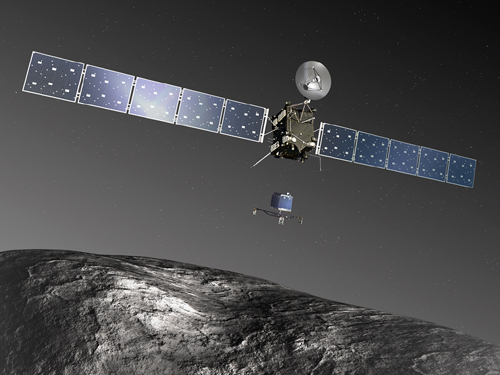
This article is a preview from the Winter 2014 edition of New Humanist. You can find out more and subscribe here.
It is a weird-looking thing – blacker than a lump of coal, shaped like a dumbbell and so small it would just about fit into London’s Richmond Park. Yet comet 67P/Churyumov-Gerasimenko is arguably the most exciting body ever visited by a robot space probe. Just as the Rosetta Stone was the key to unlocking the secrets of ancient Egypt, the European space agency’s Rosetta spacecraft may be the key to unlocking the secrets of the origin of life.
Comets are the builders’ rubble left over from the birth of the Solar System, the raw stuff out of which the Earth and planets were made, preserved unchanged for 4.55 billion years. Encounters with giant planets like Jupiter and Saturn catapulted them out towards the stars, where they orbit in a giant bee swarm of icy bodies. According to some estimates, this Oort Cloud, named after Dutch astronomer Jan Oort, may contain a trillion objects, making comets the most numerous bodies in our Solar System.
Occasionally, a gravitational nudge from a passing star kicks a comet from its sedate million-year orbit and sends it plummeting sunward. As it swings around the Sun, solar heat boils off its surface ice and dust, creating a spectacular tail, often so extensive that it is as if a mosquito were to develop a kilometre-long vapour trail. Most comets fly back out into the dark, cold reaches of the Oort Cloud. But a chance encounter with Jupiter’s gravity can trap a cometary “nucleus” permanently in the inner Solar System. This happened to comet 67P/Churyumov–Gerasimenko some time before its discovery in 1969, although nobody knows exactly when.
Rosetta has been chasing the comet for ten years, bouncing like an interplanetary bagatelle ball between the Earth and Mars to gain speed. So far from the Sun that its solar panels were ineffective, it spent two and a half years in hibernation to save energy, waking from its long sleep ten months ago like Hal the computer in 2001: A Space
Odyssey. Now Rosetta has become the first probe to ever catch a comet, flying in a shrinking triangular orbit around comet 67P/Churyumov-Gerasimenko, a loosely compacted dirty snowball with less than half the density of water.
It is going to be a hell of a ride for Rosetta and its washing-machine-sized lander, Philae, as the comet plunges towards the Sun, and great jets and geysers of ice and dust erupt from its surface, stabbing outwards into space. It is by no means certain the pair will survive for long. But, if they do, we may get answers to some very big questions.
Questions like where did the oceans come from? The Earth was born in fire, and all its water was boiled off into space from its molten surface. Scientists have speculated that the water that fills our oceans was delivered at a later time by vast numbers of impacting comets, just like comet 67P/Churyumov–Gerasimenko. Already, there is evidence that the “isotopic fingerprint” of water on one closely observed comet is similar to water in Earth’s oceans. Rosetta could prove the case once and for all.
And what about the origin of biological molecules, the amino acids and so on that are the precursors of proteins and life itself? Bodies like comet 67P/Churyumov–Gerasimenko are black because of a goo of carbon-rich “organic” molecules that coat their surfaces. Rosetta might prove that the molecules of life, like the water of life, came ultimately from space.
But there is one possibility even more extraordinary. The late Sir Fred Hoyle and his colleague Chandra Wickramasinghe promoted the idea that comets carried simple microorganisms to the young Earth – that they “seeded” our planet with life. This might explain why life on Earth got started the moment the planet was cool enough, around 4 billion years ago – implying the step from nonlife to life is an easy one – whereas scientists have patently failed to create life from nonlife in the laboratory. Hoyle had no idea how or where life got started out in space. His point was simply that, no matter how unlikely it was for life to arise, once it emerges in one place, comets, some of which shuttle back and forth between stars, provide a means to spread it throughout the length and breadth of our Milky Way.
If Hoyle and Wickramasinghe are right – and their “interstellar panspermia” idea is too controversial for most scientists – life is not merely a planetary phenomenon but a cosmic phenomenon. As Doris Lessing wrote in her novel Shikasta: “We are all creatures of the stars."
Marcus Chown’s What a Wonderful World: Life, the Universe and Everything in a Nutshell (Faber) is out now

